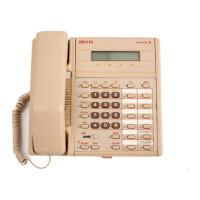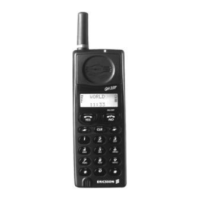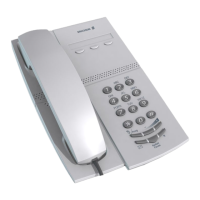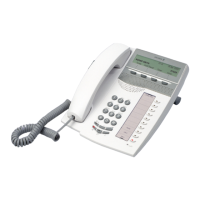Do you have a question about the Ericsson iPECS LIP-8002E and is the answer not in the manual?
General safety warnings about potential hazards like electric shock.
Specific cautions regarding phone usage, approved accessories, and potential damage.
Overview of the advanced, versatile, and fully-featured telecom system.
Information on the user guide's structure, from simple to advanced operations.
Explanation of how features are divided into logical groups for easy location.
Details on connecting the phone's Ethernet ports to the LAN and PC.
Information on powering the phone via AC/DC adapter or PoE.
Instructions for mounting the phone on a wall.
Steps to answer incoming calls when the phone is idle.
How to handle incoming calls when already on a call.
How to divert incoming calls to other stations or voicemail.
Instructions for making calls to other stations within the system.
Steps for making calls using CO or VoIP lines.
How to redial the last number called.
Instructions for storing and dialing numbers from a saved list.
Steps for transferring an active call to another destination.
Instructions on how to place an active call on hold.
Guide on creating and managing conference rooms.
How to respond to message waiting indicators.
Instructions for accessing and managing voicemail.
Enables remote users to access system resources like other stations.
Allows placing and receiving calls on a registered mobile phone.
Configuration for background music and music on hold.
Broadcasting announcements to stations and external speakers.
Assigning attributes like Authorization Codes via User Program mode.
How to assign features and functions to the phone's Flex buttons.
General safety warnings about potential hazards like electric shock.
Specific cautions regarding phone usage, approved accessories, and potential damage.
Overview of the advanced, versatile, and fully-featured telecom system.
Information on the user guide's structure, from simple to advanced operations.
Explanation of how features are divided into logical groups for easy location.
Details on connecting the phone's Ethernet ports to the LAN and PC.
Information on powering the phone via AC/DC adapter or PoE.
Instructions for mounting the phone on a wall.
Steps to answer incoming calls when the phone is idle.
How to handle incoming calls when already on a call.
How to divert incoming calls to other stations or voicemail.
Instructions for making calls to other stations within the system.
Steps for making calls using CO or VoIP lines.
How to redial the last number called.
Instructions for storing and dialing numbers from a saved list.
Steps for transferring an active call to another destination.
Instructions on how to place an active call on hold.
Guide on creating and managing conference rooms.
How to respond to message waiting indicators.
Instructions for accessing and managing voicemail.
Enables remote users to access system resources like other stations.
Allows placing and receiving calls on a registered mobile phone.
Configuration for background music and music on hold.
Broadcasting announcements to stations and external speakers.
Assigning attributes like Authorization Codes via User Program mode.
How to assign features and functions to the phone's Flex buttons.
| Type | IP Phone |
|---|---|
| Power over Ethernet | Yes |
| Speakerphone | Yes |
| Lines | 2 |
| Supported Protocols | SIP |
| Headset Port | Yes |
| Connectivity | 10/100 Mbps Ethernet |
| Ethernet Ports | 2 |
| Power Supply | PoE or optional power adapter |
| Handset Codecs | G.711, G.729 |











